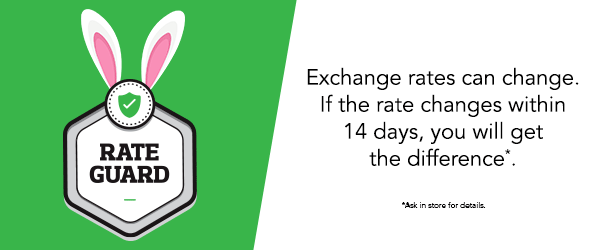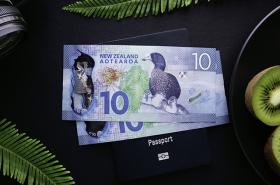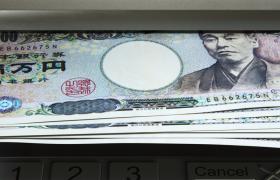Quick Contact

18th April 2019
The start of the week saw some weaker than expected data for New Zealand which put downward pressure on the value of the Kiwi dollar. Thankfully, the NZD was able to bounce back somewhat after stronger than expected Chinese data. As we prepare for the Easter long weekend, one NZD will buy you:
0.6603 US dollars
73.0169 Japanese yen
0.5749 euros
0.4982 Great British pound
0.87 Canadian dollars
0.9154 Australian dollars
0.8748 Singapore dollars
½ a packet of mini Easter Eggs
Stay up to date with the latest market news, get insights and travel money tips for your next holiday and have the chance to win $500* each month by joining the Travel Money Club.
New Zealand consumer price index (CPI) data for Q1 slowed to 1.5% YoY; down from 1.9% and a more significant decrease than the expected consensus of 1.7%.
The dovish nature (definition below) of the CPI data adds to the mounting case for a cut to Kiwi interest rates in May. Before the May meeting for the Reserve Bank of New Zealand (RBNZ), we will also see labour market data for Q1. This data will hopefully be positive and provide some clarity as to what the RBNZ’s next interest rate move will be.
Labour data aside, HSBC is now forecasting two interest rate cuts this year. These cuts are not good news for the NZD, or Kiwi travellers hoping to maximise their foreign exchange. The weak CPI data and HSBC forecasts have weighed heavy on the NZD, pushing it to the lowest rate we have seen against the USD since the start of January.
If you are travelling soon, we recommend signing up for Rate Alert so we can let you know when a currency hits your preferred rate. Don’t forget to add Rate Guard to your purchase in store as well. It’s free, and if the rate improves within 14 days of your purchase we will refund you the difference*.
Chinese data boosted by Easter chocolate sugar rush
Yesterday saw the release of China’s Gross Domestic Product (GDP) for Q1, and industrial production and retail sales results for March.
GDP came in at 6.4% YoY which was slightly ahead of the expected 6.3%. Industrial production increased by 8.5% YoY, far exceeding the consensus of 5.9%, and retail sales beat the 8.4% consensus after rising by 8.7%. Economists suggest this data proves the Chinese economy is stabilising and shoulders forecasts of an acceleration in the second half of 2019 (H2).
This data release supported the Kiwi dollar in two ways:
- New Zealand and China have strong trade ties, so an improvement in the Chinese economy is good news for NZ.
- Investment-wise, the NZD is considered a relatively ‘risky’ currency. As a result, there will be an increase in demand for the Kiwi dollar when markets are ‘risk on’ and risk appetite has improved. Risk sentiment was boosted by this stronger than expected data overnight.
With all of this in mind, markets don’t expect the NZD to rally higher off the back of this data, as the benefits were potentially already accounted for following the de-escalation of the trade tensions between the US and China. If anything, this data was just the icing on the hot cross bun needed to validate China’s stabilising economic growth.
China and US egg-cited to sign a trade deal
Speaking of the de-escalating tension between the US and China, overnight the Wall Street Journal reported that officials from both countries have scheduled a round of meetings in the hope of closing out a trade deal.
Negotiators are aiming for a signing ceremony in May or June. Should everything go smoothly, it will be good news for New Zealand and the NZD. It also means we can finally stop talking about it after about five months of pain.
Every bunny in Europe is hoping for economic improvement
This morning the European Central Bank (ECB) expressed their hopes of economic improvement, with governing council member Ardo Hansson saying there is “no reason to doubt euro-area growth will pick up in H2 19”.
Hansson’s comment’s come as a form of reassurance after a report was released yesterday showing a significant minority of ECB policymakers are not confident in currency forecasts that predict a recovery in the European economy.
The report is currently weighing on the euro, alongside the fact that the European GDP growth estimate was revised down to 0.5% for 2019. Whilst this is in line with the HSBC’s forecast, it is well below the Bloomberg forecast of 0.9%.
In addition to this, despite the strong Chinese data mentioned above, there was a contraction in Chinese car sales. This contraction is not great news for Germany, which is currently witnessing a slowdown in their manufacturing sector.
What does this mean for Kiwi travellers embarking on their European summer vacations? Well, currently the NZD is being weighed down by pressures outside of the EU’s situation. With this in mind, it is possible a variety of factors could impact the value of the NZD and cause it to either increase or decrease. Your best bet? Keep an eye on the exchange rate and purchase when it is at a high. Add Rate Guard to your purchase in-store at Travel Money NZ, and if the rate improves again within 14 days of your purchase we will refund you the difference*.
Definitions for those of us playing at home:
Dovish vs Hawkish
These are terms that refer to the general sentiment of a country’s central bank when talking about monetary policy.
The bank will take a hawkish stance when they want to prevent excessive inflation. This is often done by increasing interest rates. Increasing interest rates generally puts upward pressure on the value of that country’s currency, as investors can now get a greater return.
The bank will take a dovish stance when the economy is not growing and the government is seeking to guard against deflation. You guessed it; this could lead to decreasing interest rates which would put downward pressure on the value of the currency. Just keep in mind that this value is still relative to other countries, so a dovish stance is not always bad news for the value of the currency.
An easy way to remember: hawks fly higher than doves. So when markets talk about things being hawkish, it generally means things are going up. You normally see doves on the ground, so if there is talk of things being ‘dovish’, things may be going down.
This blog is provided for information only and does not take into consideration your objectives, financial situation or needs. You should consider whether the information and suggestions contained in any blog entry are appropriate for you, having regard to your own objectives, financial situation and needs. While we take reasonable care in providing the blog, we give no warranties or representations that it is complete or accurate, or is appropriate for you. We are not liable for any loss caused, whether due to negligence or otherwise, arising from the use of, or reliance on, the information and/or suggestions contained in this blog. All rates are quoted from the Travel Money NZ website and are valid as of 18 April 2019. *Terms and conditions apply to Rate Guard. See https://www.travelmoney.co.nz/rate-guard for more information.











